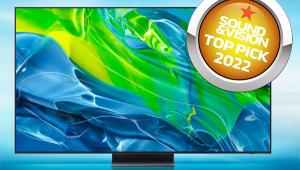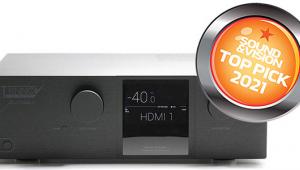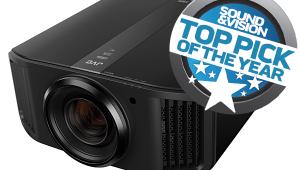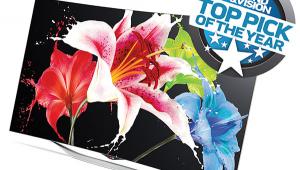Top Picks Projection Screens
| Projection Screens Screen prices vary widely by brand, size, screen material, and configuration (fixed frame or retractable tensioned/non-tensioned, etc.). Consult the manufacturer for specific pricing. Models are listed in order of when they were reviewed with the most recent first. | |
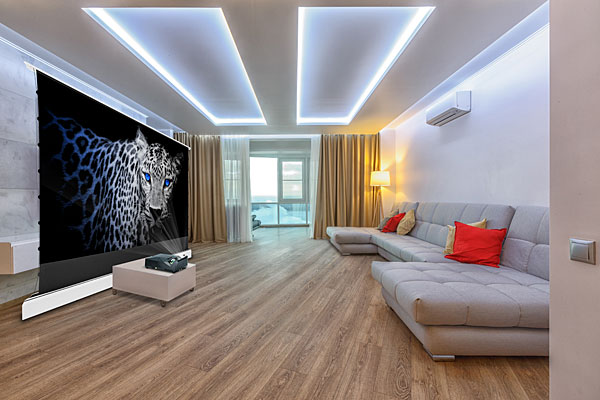
|
Elite Screens Kestrel Tab-Tension 2 CLR 3 Series Screen: $2,320 Tired of staring at a blank screen when your projector is off? Enter the Elite Screens Kestrel, a motorized, remote controllable screen that fully retracts into an inconspicuous case on the floor when it’s not in use. The screen and its supporting structure are well-made and the whole shebang is reasonably-priced and easy to set up and use for anyone who wants to make that their screen disappear at will. (August/September 2022, Read Full Review) |
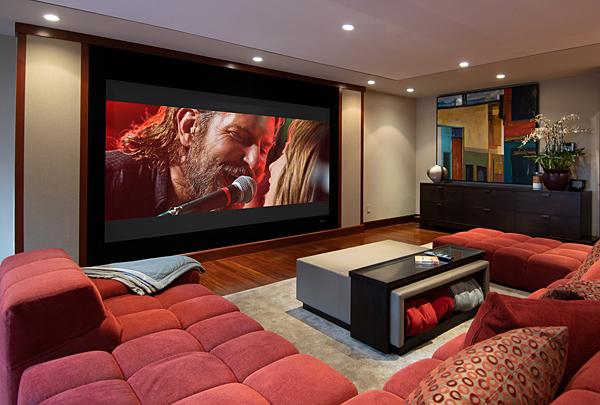 |
Stewart Filmscreen Harmony G2 Acoustically Transparent Screen: $3,242 (as tested) Stewart Filmscreen has been crafting movie-theater screens since the Golden Age of Hollywood so it’s well versed in the art of making high-performance video screens like the Harmony G2, which is designed to enhance audio fidelity without compromising image quality. Professional calibrator Michael Hamilton evaluated an 8 x 4.5-foot screen using Epson’s outstanding 5050UB and was impressed with the screen’s ability to display “fantastic detail, wonderful edge-to-edge uniformity” and pass sound without diminishing intelligibility. If there’s a caveat, it’s that the Harmony G2 demands a bright projector. (August/September 2021, Read Full Review) |
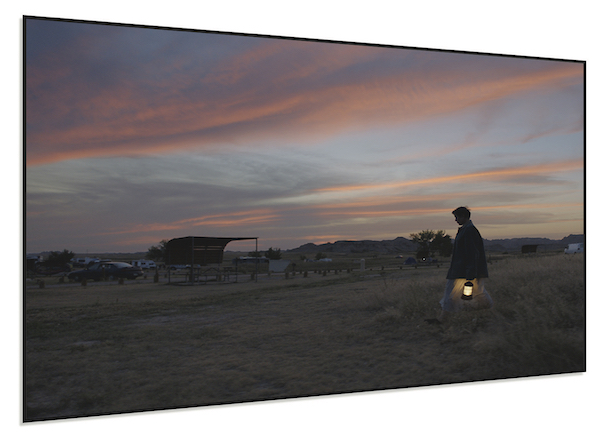 |
EPV Screens DarkStar UST 2 Efinity Projection Screen: $2,799 (as tested) EPV’s DarkStar UST 2 Efinity is an ambient-light-rejecting (ALR) screen designed for use with the new class of ultra-short-throw (UST) projectors. Using Epson’s Top Pick-designated LS500 projector, resident video expert Al Griffin put a 123-inch (diagonal) screen with a fixed-edge frame only 0.4 inches thick to the test. He was impressed with the “floating TV” look he was able to achieve and the screen’s ability to render rich, detailed images with movies and sports — even when the room’s overhead lights were left on. If you like the idea of achieving a vivid, theater-like presentation without having to turn off all of the lights, this screen can help get you there. (August/September 2021, Read Full Review) |
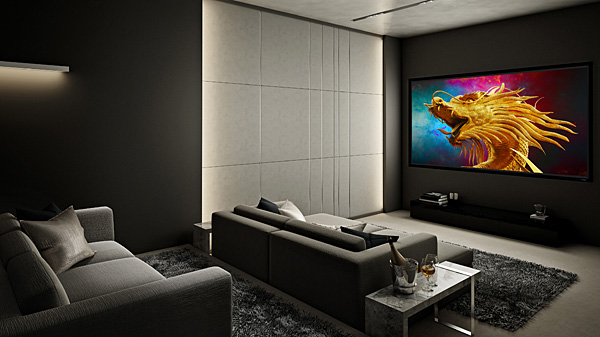 |
Stewart Filmscreen StudioTek 130 G4 Projection Screen: $1,484 (material only, as tested) The ST130 G4, the fourth generation of Stewart Filmscreen’s popular StudioTek material, is designed to preserve the fine detail and contrast of 4K/high dynamic range (HDR) sources — claims reviewer Kris Deering put to the test using a series of carefully chosen video clips. “I was actually stunned with how well the new material performed…and downright smitten with the extra brightness.” If you’re looking for a reference-caliber screen that provides a bump in brightness without artifacts, the ST130 G4 deserves serious consideration. (April/May 2020, Read Full Review) |
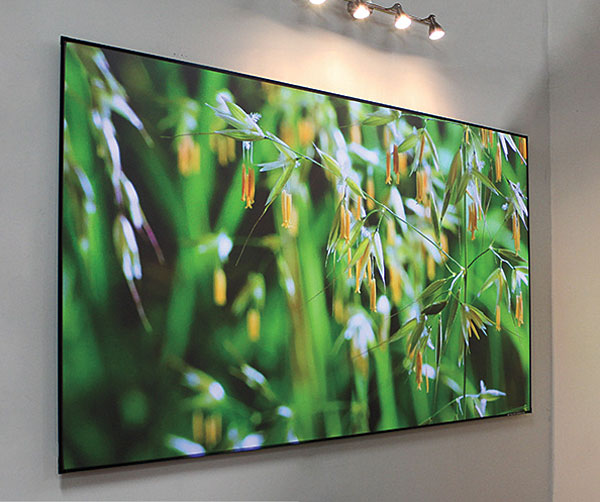 |
Elite Screens Aeon CLR Screen: $799 Resident video maven Tom Norton installed a 90-inch-diagonal screen from Elite’s Aeon CLR series for his review of Epson’s LS100 ultra-short-throw (UST) LCD projector. Sporting a 0.5-inch “edge-free” design that mimics the ultra-thin bezels of today’s flat-panel TVs, the screen is a high performing ambient-light-rejecting (ALR) model designed specifically for use with UST projectors. As Norton put it, “The Elite Aeon CLR is a great option for a budget UST projection system” — and one worthy of Sound & Vision’s 2017 Top Picks of the Year status. (February/March 2018, Read Full Review) |
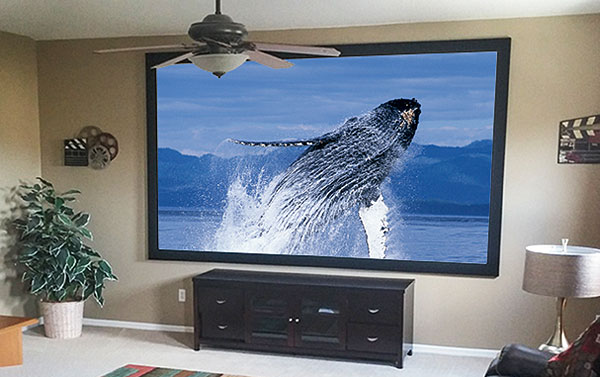 |
VApex PRO Fixed Frame Screen Review: $219 (as reviewed) The VApex PRO is the perfect option if you’re assembling a budget video projection system but don’t want to cut corners. So forget about painting the wall white and keep your bedsheets in the dresser. For 200 bucks you get a screen that’s easy to assemble and, in the words of video maven Al Griffin, performs “spot on.” Even better, choose the right projector (may we suggest the Optoma HD142X or InFocus ScreenPlay SP1080) and you’re looking at a package price of around $800. It’s hard to find a decent TV for that much. (December 2016, Read Full Review) |
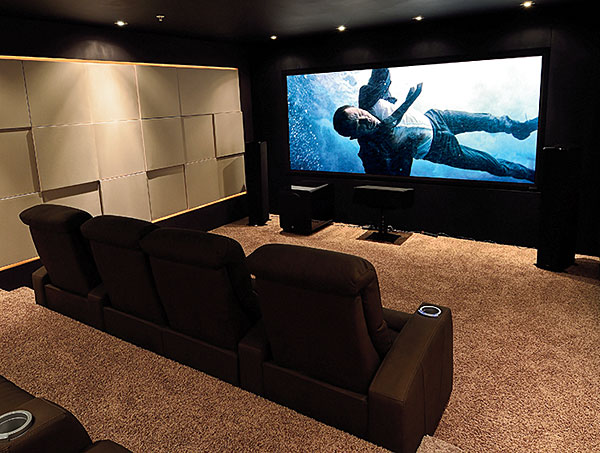 |
Seymour-Screen Excellence Ambient-Visionaire Black 1.2, $2,257 If you need evidence that a high-quality ambient-light-rejecting screen can give spectacular results, look no further. This screen is easy to assemble and does a great job enhancing contrast and black level as well. “Seen from front-on or within the maximum viewing radius in my room of around 75 degrees, this is the best execution of light rejection and lumens utilization I have yet experienced, that being with lights on,” wrote reviewer Michael Hamilton. “In theater mode with lights off, the Ambient-Visionaire Black 1.2 may be the screen that makes you forget white screens are still being made.” (April 2016, Read Full Review) |
 |
Elite Prime Vision DarkStar 9, $3,138 High-tech, high-ambient-light screens are all the rage for lifestyle installations, but Elite’s DarkStar 9 delivers exquisite color and enhanced contrast in both lit and dark spaces. (November 2015, Read Full Review) |
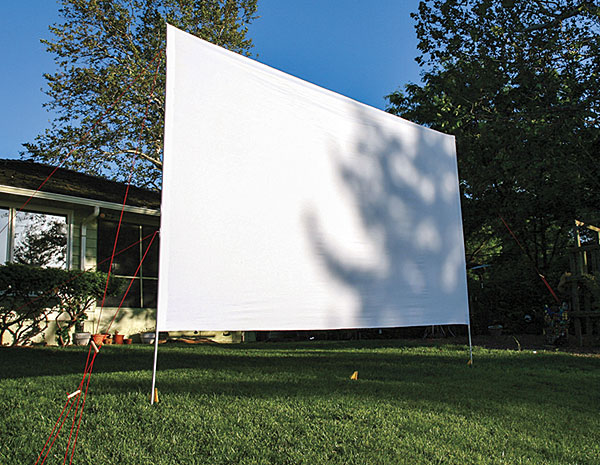 |
OutstandingScreens OSS Drive-In 16 Outdoor Screen, $549 The (almost) bygone ear of drive-in movies comes back to life with the OSS Drive-In 16, a ginormous (16 x 9-foot) weather-resistant screen that fits in a tent-like carrying bag and weighs only 20 pounds. Setting up the screen is so easy that you’ll use it over and over again to watch your favorite Hollywood blockbusters under the stars. (July/August 2015, Read Full Review) |
 |
Stewart Filmscreen StudioTek 100 The StudioTek 100 ($3,097 as reviewed) is very similar to the StudioTek 130, which many regard as the reference standard, in that it aims to provide excellent color and light uniformity. The difference? It lacks the subtle screen texturing you may see with the 130 because it doesn’t try to add gain (its specified gain is 1.0). Put this screen in a dark environment with a kick-ass projector and it will allow pristine images with near perfect brightness and color uniformity to shine through. The StudioTek 100 is yet another example of why the name Stewart Filmscreen is synonymous with “reference-quality projection screen.” (November 2014, Read Full Review) |
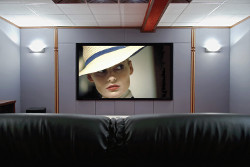 |
Seymour-Screen Excellence Reference Series Enlightor 4K The ISF-certified, 4K-optimized Enlightor screen is easy to assemble and puts dialogue where it belongs without obliterating high-frequency detail thanks to its woven, acoustically transparent make-up. Tested with the JVC DLA-X30 projector, the 96-inch-wide 2:37:1 screen we reviewed ($2,773) produced a pleasingly bright picture. Summing up his visual impressions, reviewer Tom Norton wrote: “Its uniformity was excellent, its colors bright and true, and its resolution satisfying.” If a crisp vivid picture with respectable transparency to sound is what you’re looking for, the Enlightor deserves serious consideration. (May 2014, Read Full Review) |
 |
Stewart Filmscreen Cima Stewart’s Cima lineup offers fewer options than the company’s long-respected and costlier screens but brings pristine image quality to a wider audience. Available in fixed or retractable versions, the 110-inch Cima Neve (white) fixed screen ($1,675) we tested was plenty bright and set the stage for superb color and crisp resolution. Summing up, projector expert Tom Norton wrote: “The Cima is a superb projection screen. What counts is the picture, and in that regard I found nothing whatsoever to complain about.” (May 2014, Read Full Review) |
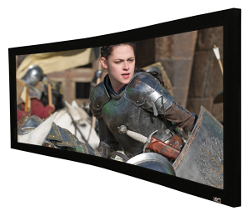 |
Elite Lunette Curved If you’re ready to take your home theatrical experience to new heights, the gently curved Elite Lunette screen is a superb performer and a great value (the version we reviewed costs $1,600.) Its curved frame is covered in nonreflective black velvet and the back of the screen is blackened to eliminate light penetration—a feature you won’t find on many costlier screens. We reviewed the CineWhite version but Lunette is also available with a woven, acoustically transparent screen material called AcousticPro1080p. In the words of veteran video reviewer Tom Norton: “I loved what the curved screen did to enhance the cinematic feel of movies, and if my home installation allowed for such a screen…I’d choose the Elite Lunette without hesitation.” (April 2013, Read Full Review) |
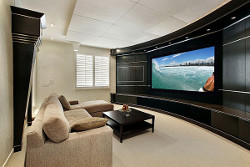 |
Screen Innovations Black Diamond G2 4K The G2 4K is the 4K version of the Black Diamond II screen we reviewed in 2011 (below). It literally shines with brightness, making it an ideal choice if some of your viewing will be done amid ambient light. The G2 4K is offered with three specified gains: 0.8, 1.4, and 2.7. We tested the 1.4 version with a flat, fixed frame covered in black velvet and screen material that is thick and rigid ($2,899 as reviewed). Summing up his impressions, reviewer Tom Norton wrote: “SI screens are unique products that, under the right conditions, offer compelling performance for users who otherwise might not even consider a video projection/screen setup.” (April 2013, Read Full Review) |
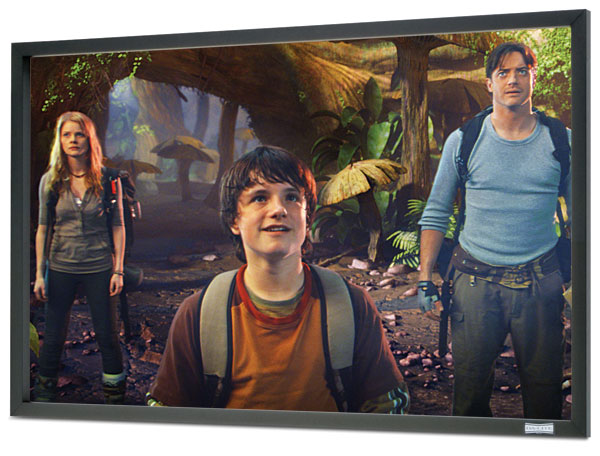 |
Da-Lite High Power Da-Lite’s High Power 2.4 gain screen material, which was tested to gauge its effectiveness with 3D, was both affordable and surprisingly high performance given the usual sacrifices made to achieve higher gain. Reviewer Tom Norton found it to be “notably free of visible texture and hotspots…This lack of a hotspot is a remarkable achievement for such a high-gain screen, and the characteristic of the Da-Lite that surprised me the most. (May 2012, Read Full Review) |
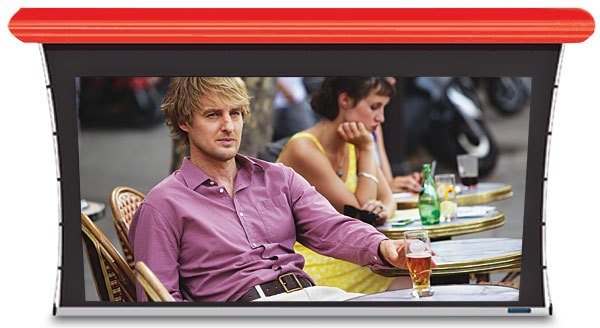 |
Stewart Reflections Active 170 3D Stewart’s 1.7 gain Active 170 material provides ultra-high gain for additional brightness for viewing 3D content, though you’ll sacrifice some light uniformity and off-axis performance on 2D compared with a lower gain, more general purpose screen. Reviewer Tom Norton noted that “the Reflections is a good overall performer. It produces a comfortable but not a striking increase in brightness over its StudioTek 130 G3 sibling. It cannot match the latter in color uniformity as you move off-axis, but the changes were slight enough that even the moderately critical viewer isn’t likely to be bothered by them. The decrease in brightness as you move off-axis at a reasonable angle (about 30 degrees) is gradual and barely visible.” (May 2012, Read Full Review) |
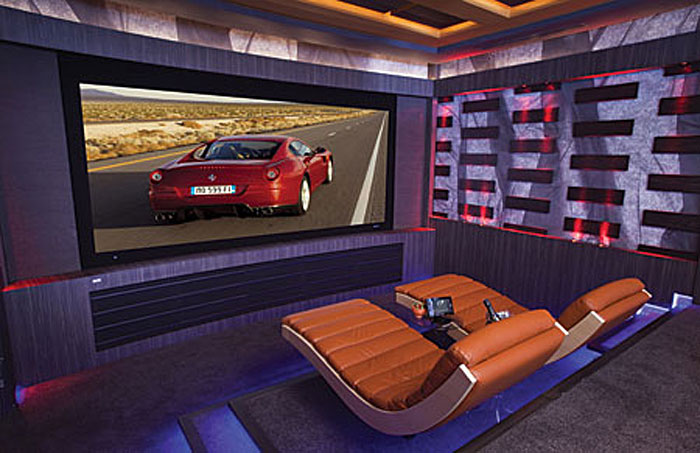 |
Stewart Filmscreen StudioTek 130 This 1.3 gain white screen from Stewart Filmscreen is among the most highly regarded and popular materials among serious enthusiasts for 2D viewing in environments with fully controlled lighting; it is the closest thing we have to an industry standard screen and it is the screen used by nearly all of Home Theater’s reviewers. In full darkness it provides just enough additional gain over a 1.0 unity screen to give smaller home theater projectors a little extra punch without hotspotting or other obvious artifacts. Although we’ve never formally reviewed this screen, our everyday experience with it easily earns it honorary Top Pick honors, though it is also one of the most expensive screens you can buy, easily costing two to three times more than some of the more attractively priced materials out there. Depending on screen size and the projector, it may also fail to provide enough gain for satisfying 3D viewing. (July 2011, Read Full Review) |
 |
Screen Innovations Black Diamond II Screen Innovations has continued to blaze a path with new and improved iterations of the Black Diamond screen we reviewed in early 2011, adding additional gain options (it’s now available in 0.8, 1.4, and 2.7 gain versions, as well as a new retractable version introduced in late 2012 and a Zero Edge model with almost no visible border that can be mounted to a wall or hung from a ceiling. In any version, it is designed to optimize viewing in subdued to normal ambient light conditions, providing exceptional performance when the lights are on. Reviewer Tom Norton was impressed; although it won’t deliver the performance of a good screen in a fully darkened room, “with discreetly positioned lighting sufficient for eating, conversing easily with others, and even multitasking (we used to call that reading), the Black Diamond will get the job done better than any other screen I know of.” (May 2011, Read Full Review) |
- Log in or register to post comments
